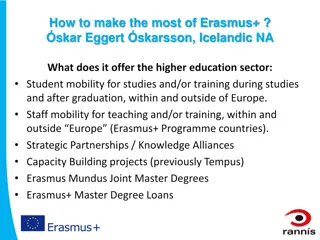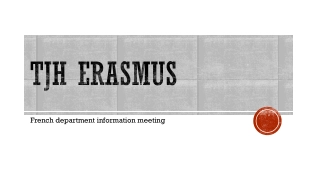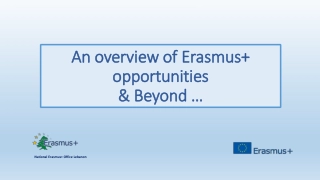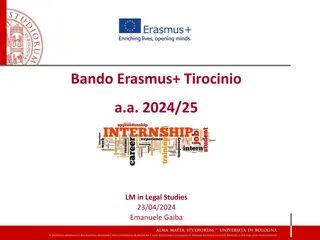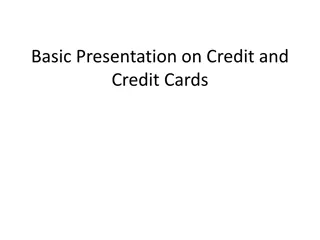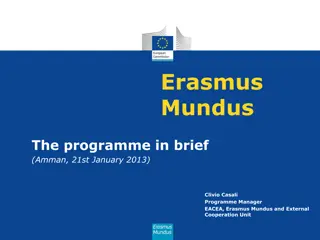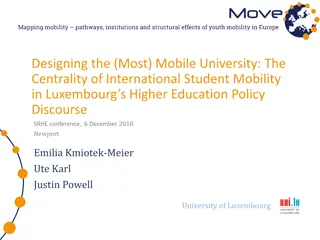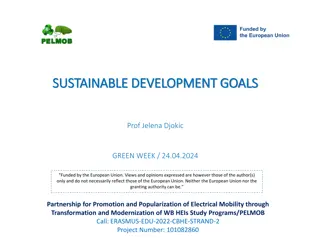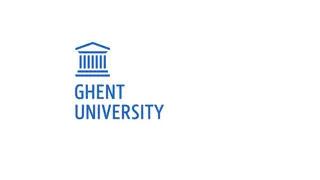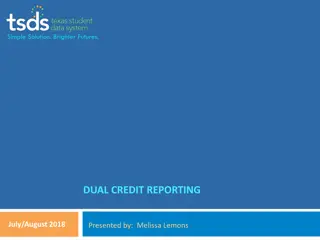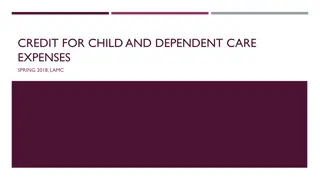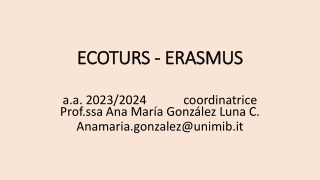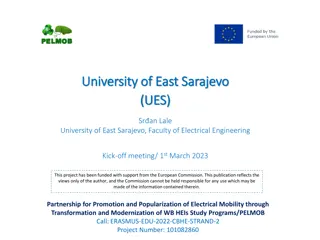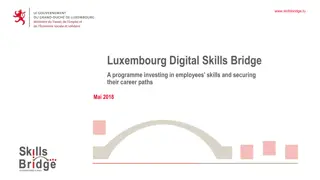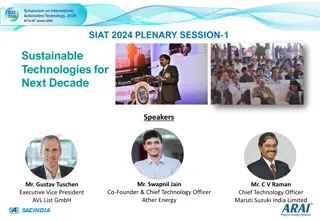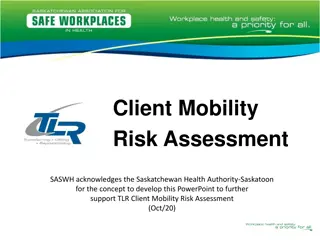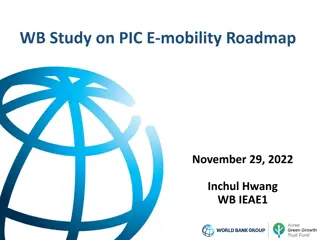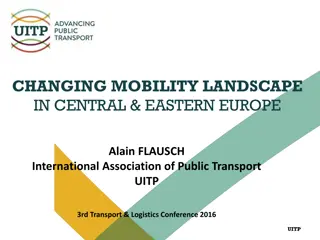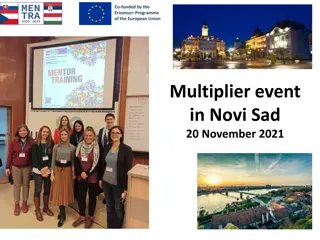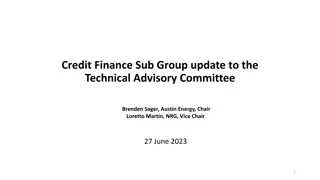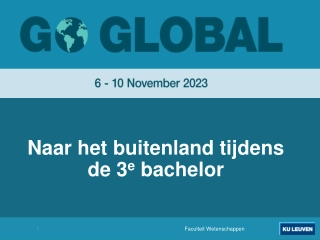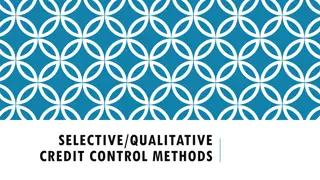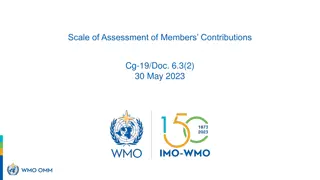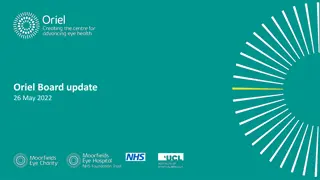Erasmus+ Programme 2021-2027: International Credit Mobility Updates
The Erasmus+ Programme for 2021-2027 introduces novelties in International Credit Mobility (ICM) including changes in funding allocation, participant profiles, application processes, and budget distribution across regions. These updates aim to enhance flexibility, streamline budget management, and promote collaboration between High-Income Countries (HICs) and Least Developed Countries (LDCs) in student and staff mobility.
Download Presentation

Please find below an Image/Link to download the presentation.
The content on the website is provided AS IS for your information and personal use only. It may not be sold, licensed, or shared on other websites without obtaining consent from the author. Download presentation by click this link. If you encounter any issues during the download, it is possible that the publisher has removed the file from their server.
E N D
Presentation Transcript
International credit mobility (KA171) in the Erasmus+ programme 2021-2027 Call 2022, novelties Online information meeting, 18 November 2021 Antoaneta Irikova Unit of C3, International Cooperation DG EAC
International dimension of Erasmus+ 2021-2027 Mixed funding of Int l dimension of E+: E+ budget line (H2) and External financial instruments (H6) Heading 6: 2.174 billion EUR (1.932 billion EUR 2014-2020): IPA III (WB, 374 million EUR) NDICI (rest of the world, 1,8 billion EUR) Slight difference in the composition of the regions compared to 2014-2020 New regions Mix of High income countries (HICs) and Least developed countries (LDCs)
International credit mobility 2014-2020 ~270k planned short-term staff and student mobilities 40 Thousands 35 30 25 20 15 10 5 0 to Europe from Europe
ICM in the Netherlands 2015-2020 Participants profile per year 2015-2020 132 projects awarded Incoming students Incoming staff Outgoing students Outgoing staff 7 190 planned mobilities: 309 253 241 63/37 incoming/outgoing 167 260 121 294 40/60 student/staff mobility 170 536 348 29 466 142 257 281 8 232 55 57 69 214 59 7 74 406 38 69 8 316 311 41 276 5 86 223 76 69 77 129 127 85 53 48 35
ICM in the new Erasmus+ programme:budget 2021-2027 2014-2020 Middle East 1% Pacific 1% Latin America 3% Caribbean Central Asia 2% Central Asia 4% Middle East 1% Asia 9% Asia 13% WB 19% WB 18% Industrialise d Asia 4% Latin America 4% Industrialise d Americas 4% 1% ~EUR 959 million ~EUR 1,064 billion SMED 17% USA & Canada 3% SMED 21% SSA 26% ACP 8% EaP 12% Russia 8% EaP 15% Russia 6%
International Credit Mobility (ICM) in the new Erasmus+ programme: novelties (I) Application form regional approach: 3 quality questions: one at project level and two for each region the applicant intends to cooperate with Apply only for student/staff mobility without specifying types of activity (studies/ traineeships or teaching/training) Shift funds between countries in the same region => more flexible budget management Estimation of participants with fewer opportunities
International Credit Mobility (ICM) in the new Erasmus+ programme: novelties (II) Enhanced opportunities with a focus on inclusion: blended mobilities - short physical mobility of 5 to 30 days combined with a virtual component, opening up to recent graduates for traineeships, > flexible format for doctoral candidates
ICM in the new Erasmus+ programme: novelties (III) Individual and travel support contributions will remain the same: EUR 700-900/month for students and EUR 140-180/day for staff Physical activity as part of blended mobility: EUR 70/day up to the 14th day of activity and EUR 50/day from 15th to the 30th day of activity Increased OS from EUR 350 to 500 per participant Top-ups for participants with fewer opportunities and special organisational support to HEIs Top-up for green travel
ICM in the new Erasmus+ programme: novelties (IV) Priorities and indicative geographical targets different regions to be attained at European level over the whole duration of the programme: Restrictions for outgoing short, 1st and 2nd cycle students in almost all regions For the purposes of ICM, only incoming mobilities and outgoing PhD and staff mobilities are considered DAC-able (= contributing to the development assistance of the recipient countries). The mixed composition of the regions, combining High income and Developing countries, makes it more difficult to distinguish regions that allow or restrict outgoing student mobility (for short-, 1st and 2nd cycle) Outgoing mobilities for these study cycles towards countries that are on the OECD ODA list are restricted (WB countries may be exempted from this rule)
International opening of KA131 (I) Two strands of the international dimension: International outgoing mobility supported by internal policy funds (KA131) International outgoing and incoming mobility supported by external policy funds (KA171) Funding sources: KA131: H2 => up to 20% of project grant for international mobility, one budget for the whole world KA171: H6, earmarked budget envelopes per region
International opening of KA131 (II) Available funding in 2022 and beyond: KA131: 194m (with max 20% use) KA171: 169m Geographical scope and flows: KA131: worldwide, only outgoing mobility KA171: worldwide except Regions 13 and 14, geographical targets
International opening of KA131 (III) Application: KA131: only indicative % for international mobility KA171: quality assessment per region & approval of country flows Implementation mode: KA131: selection of partner countries & HEIs during implementation KA171: approval of partner countries and HEIs during application Complementarity between the two strands
Timeline Publication of the call: second half of November 2021 Evaluation process: March - July 2022 Deadline: end of February 2022 Information to applicants August 2022 Start of projects: 1 August 2022



